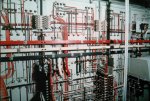mstrlucky74
Senior Member
- Location
- NJ
Well, Mr. Lucky...do you feel...
...well, do ya...punk?
Seriously...why risk it? There's likely enough fault current to blow your head clean off...
I know you can “cowboy” anything but is it safe/practical to terminate feeders on this extg. switch while the board is live? Thanks.
Well, Mr. Lucky...do you feel...
...well, do ya...punk?
Seriously...why risk it? There's likely enough fault current to blow your head clean off...
the amount of fault current is not what matters.
is it safe/practical to terminate feeders on this extg. switch while the board is live? Thanks.
Yes, with the switch open, you can terminate on the load side of the fuses. You need to do a hazard assessment including an arc flash analysis and determine what PPE and other protective equipment you will need, provide training on use of PPE, and go over how the work will be performed.
or,
Just don't work hot.
Agreed as long as all safety precautions are taken I don't see why you can't open the switch and terminate on the load side of the lugs with the switch dead. I understand some may not like doing that but I've seen it done in the field countless times safely.
"Safely" and "without getting killed" are not the same thing.
I beg to differ. Yes, the thing you are touching is not energized. But you are only a sneeze, or a slip of the tool, or a leg cramp, or one of a million other possibilities away from losing just a bit of your balance, resulting in contact with a live part. In that sense, it is not safe, even if it never happened to you.Well that depends partially on the person performing the work ;-)
"An accident waiting for a place to happen will, given time, find that place." {Famous words from some famous person.}
"Safely" and "without getting killed" are not the same thing.
Yes, with the switch open, you can terminate on the load side of the fuses. You need to do a hazard assessment including an arc flash analysis and determine what PPE and other protective equipment you will need, provide training on use of PPE, and go over how the work will be performed.
or,
Just don't work hot.


